Things You'll Need
Hot, soapy water (first time only)
Paper towel
Oil or melted solid fat
Sheet pan
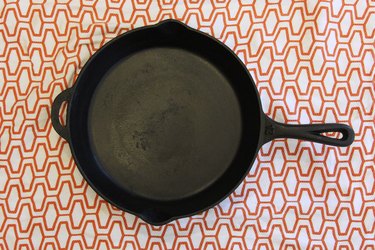
Cast iron -- the heavy, black pots and skillets used for centuries -- is the original non-stick cookware. When properly prepared, or "seasoned," cast-iron skillets are as reliably non-stick as the best of modern pans, with the added virtue that their surface improves over time rather than deteriorating. The seasoning process is simple and requires no special tools. Note: If you have a cast iron skillet that's past its prime, we'll show you how to clean and restore it to mint condition.
Step 1
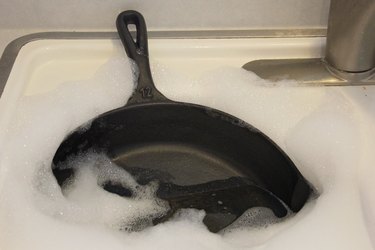
Scrub new cast iron skillets thoroughly with hot, soapy water. Most manufacturers apply a protective coat of wax or shellac to prevent their pans from rusting, and this must be removed before you proceed. Scour used skillets to remove any rust or cooked-on food. Dry your pans thoroughly before you move on to the next step.
Video of the Day
Step 2

Preheat your oven to a temperature of 350 to 400 degrees Fahrenheit. Rub the entire surface of your skillet, inside and out, with a clean paper towel moistened with cooking oil or a melted solid fat such as lard or shortening.
Step 3
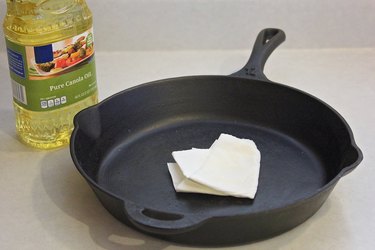
Wipe the surface of your skillet once again with a clean towel, to remove any surplus fat. A thin, nearly invisible film of oil will remain on the porous surface of the cast iron.
Step 4
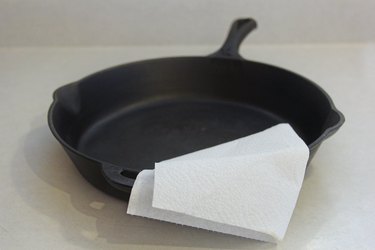
Slide a sheet pan onto the bottom rack of your oven to catch any drips and place your cast iron skillet upside down on the rack above it. Bake the pan for one hour at this temperature, then turn off the oven and let it cool gently to room temperature.
Step 5
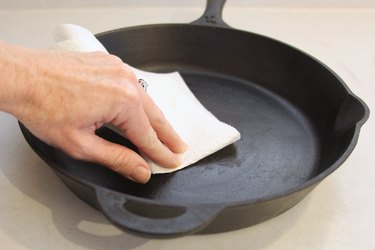
Re-oil your pan and repeat the heating and cooling cycle another 2 to 3 times, or up to 6 times, for an improved non-stick surface. This is optional, but because it creates a better "base" of seasoning, you won't need to exercise as much care when later using your skillet.
Tip
Seasoning works because the combination of heat and oxygen breaks down your oil, causing it to "polymerize" or form large, tough molecules that adhere stubbornly to your pan's porous surface. Many modern non-stick coatings reproduce this same effect, artificially.
Traditional lore called for lard as the seasoning fat of choice, though modern cooks tend to use whichever oil is at hand. The best are fats with a relatively low smoke point, which polymerize easily. Corn and soybean oil are good choices, and some enthusiasts swear by flaxseed oil from the supermarket's health food section. High-temperature oils -- a better choice for most cooking tasks -- work poorly and can leave the pan feeling tacky. If that's the result of your first effort at seasoning, simply return your pan to the oven at a higher temperature of 500 F for a full heating and cooling cycle. This will create the desired baked-on finish.
To protect your finish, use the pot or pan solely for frying the first few times you use it. Preheat the pan first, then -- once it's up to temperature -- add your oil and begin cooking. When you're finished, rinse the pan with hot water and a soft brush or cloth and dry it thoroughly. Wipe a light coating of oil over the pan before storing it, to protect the finish.
Don't use soap or scouring pads to remove stuck-on food, because both will damage your finish. Instead, culinary professionals apply coarse salt. Heat your skillet to cooking temperature, and dump in 1/2 cup to 1 cup of coarse salt. Wad up a kitchen towel to protect your hands from the hot salt, and use it to scour the pan. When the pan is smooth again, pour the hot salt into an empty food can or other heatproof container. Wipe out any salt residue, let the pan cool, and then wipe it with oil before storing it.
Used pans with a badly chipped or pitted surface can be stripped to the bare metal using oven cleaner, then washed thoroughly and re-seasoned from scratch. They'll usually require several seasoning cycles before a reliably non-stick surface can be re-established.
Pans that come pre-seasoned from the manufacturer can be used immediately, but still benefit from at least one or two cycles of home seasoning as well.
Warning
Cast iron retains heat superbly, which is its great culinary strength but also represents a burning hazard. For safety's sake, always assume the handle is hot and handle it with oven mitts or a folded towel.
Never put cast-iron pans through your dishwasher. The potent chemicals in dishwasher detergent can strip the finish from your pan, or -- even worse -- strip only part of it, leaving a maddeningly inconsistent surface.
Video of the Day